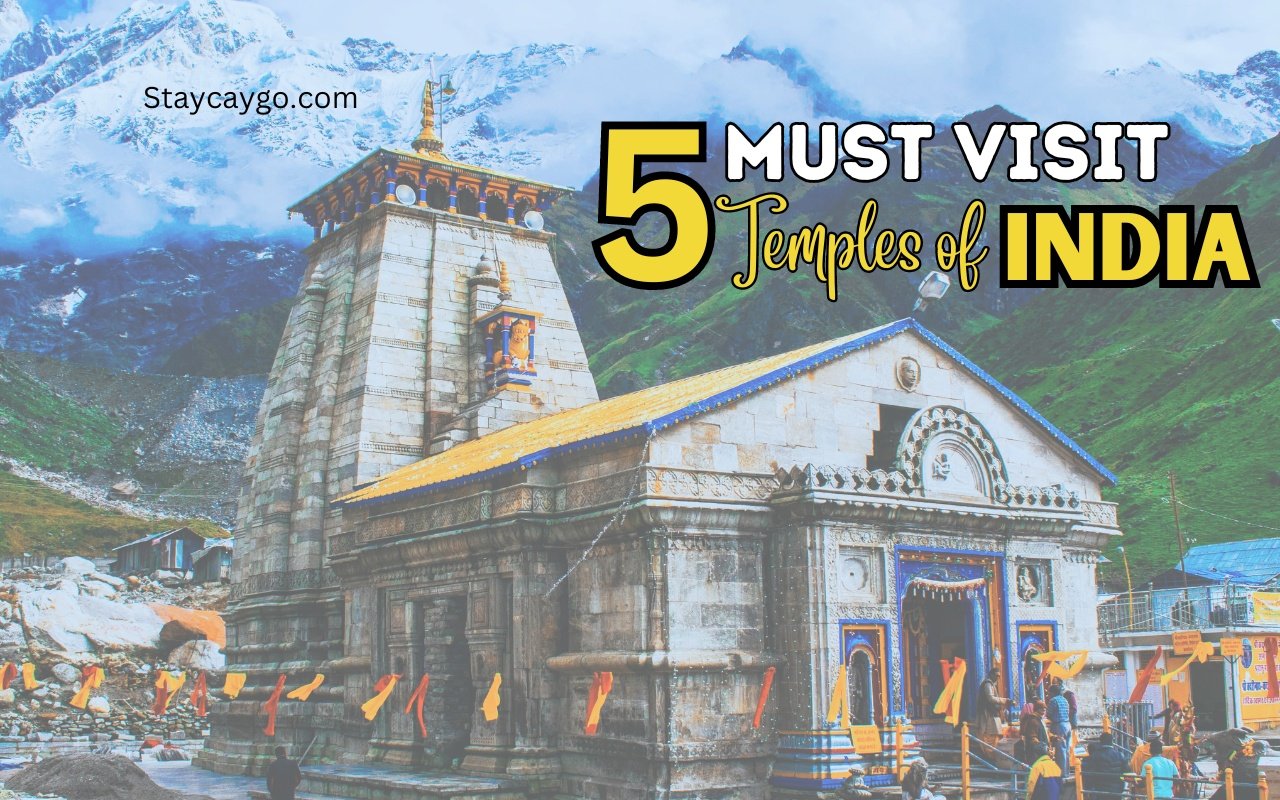India, a land of diverse cultures and spiritual heritage, is home to countless temples that showcase its rich history and architectural prowess. In this guide to the Top 5 Must Visit Temples in India, we’ll take you on a journey to the most revered and awe-inspiring sacred sites, where ancient traditions meet stunning beauty and deep spirituality.
Temples of timeless beauty and faith
SCG Team
Top 5 Must Visit Temples in India
- Kedarnath Temple
- Rameshwaram Temple
- Badrinath Temple
- Somnath Temple
- Vaishno Devi Temple
Kedarnath Temple
Kedarnath Temple, situated in the Garhwal Himalayas of Uttarakhand, India, is a highly venerated Hindu shrine dedicated to Lord Shiva. It is recognized as one of the twelve Jyotirlingas and serves as a significant pilgrimage destination for Hindus. Positioned at an elevation of 3,583 meters, the temple is enveloped by stunning mountain vistas and is in close proximity to the Mandakini River. According to ancient tales, the Pandavas, renowned figures from the Mahabharata, constructed the temple, which is believed to be more than a millennium old.
Despite its age, the present structure dates back to the 8th century and has undergone multiple renovations. The temple’s architecture showcases a fusion of stone and wood, featuring elaborate carvings and sculptures embellishing its walls. Inside, a sizable stone lingam symbolizes Lord Shiva, with devotees offering prayers and worship all year round. Owing to severe winters, the temple is accessible only from May to October, with devotees braving arduous terrain to visit this sacred location. Kedarnath Temple stands as a testament to India’s profound spiritual legacy and embodies qualities of devotion, resilience, and natural splendor.
Rameshwaram Temple
Rameshwaram Temple, situated on the Pamban Island in Tamil Nadu, India, is a highly venerated Hindu sanctuary dedicated to Lord Shiva. It is considered one of the twelve Jyotirlingas and a significant pilgrimage destination, particularly for those seeking redemption from their sins. According to tradition, Lord Rama, the protagonist of the Ramayana, constructed the temple to seek forgiveness for killing Ravana, a Brahmin. The architectural style of the temple is a fusion of Dravidian and Nagara influences, featuring towering gopurams, intricate carvings, and ornate pillars. The inner sanctum houses a lingam, believed to have been installed by Lord Rama himself.
The temple complex also includes a sacred tank, Agni Theertham, where worshippers bathe before offering prayers. Rameshwaram Temple is renowned for its breathtaking beachside setting, picturesque surroundings, and the revered Adi Shankara shrine. Its significance extends beyond spirituality, symbolizing India’s rich cultural heritage and the victory of good over evil. Pilgrims from around the world visit Rameshwaram to seek blessings, absolve their sins, and experience the divine presence of Lord Shiva.
Badrinath Temple
Badrinath Temple, located in the Chamoli district of Uttarakhand, India, is a sacred Hindu shrine dedicated to Lord Vishnu. Positioned at an elevation of 3,133 meters, it stands as one of the four Char Dham pilgrimage sites and a significant spot for followers in pursuit of spiritual growth. As per ancient tales, Lord Vishnu manifested as a child before sage Narada and sage Nara, leading to the construction of the temple by Adi Shankara during the 9th century.
The architectural style of the temple combines elements of Garhwali and Dravidian influences, showcasing a unique black stone statue of Lord Vishnu, known as Badrinarayan, enshrined within its walls. The temple complex includes a Tapt Kund, a thermal spring believed to possess healing properties, as well as the nearby Alakananda River. Devotees revere Lord Vishnu as Badrinarayan, seeking release from the cycle of life and death. Due to severe winter conditions, the temple is accessible only from May to October. Badrinath Temple stands as a testament to India’s profound spiritual legacy, embodying values of devotion, faith, and the pursuit of self-realization.
Somnath Temple
Somnath Temple, situated in Veraval, Gujarat, India, is a sacred Hindu shrine dedicated to Lord Shiva. It is recognized as one of the twelve Jyotirlingas and holds great importance as a pilgrimage destination, being considered the foremost among the twelve. As per ancient tales, the temple was constructed by the Moon God, Soma, as a way to repent for his mistake of marrying the twenty-seven daughters of Daksha without his consent. Over the years, the temple has faced destruction and subsequent reconstruction multiple times, with the present-day structure tracing back to the 20th century.
The architectural style of the temple is a fusion of Chalukyan and Solanki influences, featuring elaborate carvings and sculptures embellishing its walls. Within the sanctum sanctorum lies a grand lingam, believed to be the primary Jyotirlinga, set amidst a picturesque beachside setting. Somnath Temple is celebrated for its historical significance, spiritual value, and connection to India’s diverse cultural heritage. Pilgrims from around the world visit Somnath to seek blessings, cleanse themselves of sins, and encounter the divine aura of Lord Shiva.
Vaishno Devi Temple
The Vaishno Devi Temple, situated in Katra, Jammu and Kashmir, India, is a sacred Hindu shrine dedicated to Goddess Vaishno Devi, an incarnation of Goddess Durga. Positioned at an elevation of 1,584 meters, it is among the most frequented pilgrimage destinations in India. As per the legend, the goddess materialized in the form of a young girl to a devotee named Pandit Sridhar, and subsequently revealed herself as a formidable deity. The temple complex showcases three natural rock formations, referred to as pindis, symbolizing the three goddesses – Mahakali, Mahalakshmi, and Mahasaraswati.
Pilgrims embark on a demanding 13-kilometer journey from Katra to the temple, overcoming steep cliffs and dense forests. The temple is open all year round, except for a few days during the winter season. The Vaishno Devi Temple represents devotion, faith, and the victory of good over evil, drawing millions of pilgrims in search of blessings, spiritual development, and enlightenment. Its breathtaking natural surroundings, scenic landscapes, and tranquil ambiance enhance its spiritual significance, creating a truly exceptional and unforgettable experience.
Conclusion
Top 5 Must Visit Temples in India are a testament to the country’s rich cultural heritage and spiritual significance, leaving an indelible mark on the hearts of those who visit them. There sacred sites are not only breathtakingly beautiful but also embody the essence of India’s diverse traditions and beliefs, making them a must-visit for anyone seeking a deeper understanding of this incredible nation


